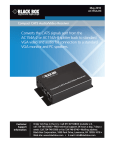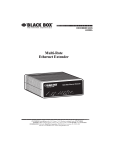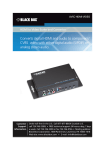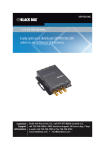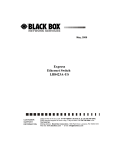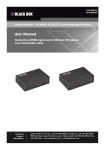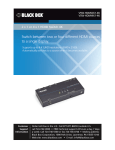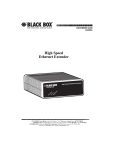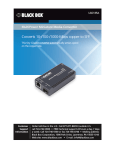Download Model AC155A-R3 Compact CAT5 Audio/Video Receiver
Transcript
AC155A-R3 UMA1088 Rev B Compact CAT5 Audio/Video Receiver Converts the CAT5 signals sent from the AC154A-2 or AC154A-8 splitter back to standard VGA video and audio for connection to a standard VGA monitor and PC speakers. TRADEMARKS USED IN THIS MANUAL Compact CAT5 Audio/Video Receiver BLACK BOX and its logo Technologies, Inc. are registered trademarks of BB Apple and Macintosh are registered trademarks of Apple Computer, Inc. Belden Brilliance® is a registered trademark and VideoTwist™ is a trademark of Belden Technologies, Inc. IBM is a registered trademark of International Business Machines Corporation. SGI is a registered trademark of Silicon Graphics, Inc. Sun and Sun Microsystems are registered trademarks of Sun Microsystems, Inc. in the United States and other countries. Any other trademarks mentioned in this manual are acknowledged to be the property of the trademark owners. 11 Compact CAT5 Audio/Video Receiver FEDERAL COMMUNICATIONS COMMISSION AND INDUSTRY CANADA RADIO FREQUENCY INTERFERENCE STATEMENTS This equipment generates, uses, and can radiate radio-frequency energy, and if not installed and used properly, that is, in strict accordance with the manufacturer’s instructions, may cause interference to radio communication. It has been tested and found to comply with the limits for a Class A computing device in accordance with the specifications in Subpart J of Part 15 of FCC rules, which are designed to provide reasonable protection against such interference when the equipment is operated in a commercial environment. Operation of this equipment in a residential area is likely to cause interference, in which case the user; at own expense; will be required to take whatever measures may be necessary to correct the interference. Changes or modifications not expressly approved by the party responsible for compliance could void the user’s authority to operate the equipment. This digital apparatus does not exceed the Class A limits for radio noise emission from digital apparatus set out in the Radio Interference Regulation of Industry Canada . Le présent appareil numérique n’émet pas de bruits radioélectriques dépassant les limites applicables aux appareils numériques de classe A prescrites dans le Règlement sur le brouillage radioélectrique publié par Industrie Canada. 22 Compact CAT5 Audio/Video Receiver Normas Oficiales Mexicanas (NOM) Electrical Safety Statement INSTRUCCIONES DE SEGURIDAD 1. 2. 3. 4. 5. 6. 7. 8. 9. 10. 11. 12. Todas las instrucciones de seguridad y operación deberán ser leídas antes de que el aparato eléctrico sea operado. Las instrucciones de seguridad y operación deberán ser guardadas para referencia futura. Todas las advertencias en el aparato eléctrico y en sus instrucciones de operación deben ser respetadas. Todas las instrucciones de operación y uso deben ser seguidas. El aparato eléctrico no deberá ser usado cerca del agua—por ejemplo, cerca de la tina de baño, lavabo, sótano mojado o cerca de una alberca, etc. El aparato eléctrico debe ser usado únicamente con carritos o pedestales que sean recomendados por el fabricante. El aparato eléctrico debe ser montado a la pared o al techo sólo como sea recomendado por el fabricante. Servicio—El usuario no debe intentar dar servicio al equipo eléctrico más allá a lo descrito en las instrucciones de operación. Todo otro servicio deberá ser referido a personal de servicio calificado. El aparato eléctrico debe ser situado de tal manera que su posición no interfiera su uso. La colocación del aparato eléctrico sobre una cama, sofá, alfombra o superficie similar puede bloquea la ventilación, no se debe colocar en libreros o gabinetes que impidan el flujo de aire por los orificios de ventilación. El equipo eléctrico deber ser situado fuera del alcance de fuentes de calor como radiadores, registros de calor, estufas u otros aparatos (incluyendo amplificadores) que producen calor. El aparato eléctrico deberá ser connectado a una fuente de poder sólo del tipo descrito en el instructivo de operación, o como se indique en el aparato. Precaución debe ser tomada de tal manera que la tierra fisica y la polarización del equipo no sea eliminada. 33 Compact CAT5 Audio/Video Receiver 13. 14. 15. 16. 17. 18. 44 Los cables de la fuente de poder deben ser guiados de tal manera que no sean pisados ni pellizcados por objetos colocados sobre o contra ellos, poniendo particular atención a los contactos y receptáculos donde salen del aparato. El equipo eléctrico debe ser limpiado únicamente de acuerdo a las recomendaciones del fabricante. En caso de existir, una antena externa deberá ser localizada lejos de las lineas de energia. El cable de corriente deberá ser desconectado del cuando el equipo no sea usado por un largo periodo de tiempo. Cuidado debe ser tomado de tal manera que objectos liquidos no sean derramados sobre la cubierta u orificios de ventilación. Servicio por personal calificado deberá ser provisto cuando: a. El cable de poder o el contacto ha sido dañado; u b. Objectos han caído o líquido ha sido derramado dentro del aparato; o c. El aparato ha sido expuesto a la lluvia; o d. El aparato parece no operar normalmente o muestra un cambio en su desempeño; o e. El aparato ha sido tirado o su cubierta ha sido dañada. Compact CAT5 Audio/Video Receiver Contents 1. SPECIFICATIONS .........................................................................6 VIDEO ................................................................................................6 AUDIO ................................................................................................6 GENERAL ..........................................................................................6 2. OVERVIEW ....................................................................................7 2.1 INTRODUCTION ...........................................................................7 2.2 FEATURES ..................................................................................7 2.3 WHAT’S INCLUDED ......................................................................8 2.4 HARDWARE DESCRIPTION ...........................................................8 3. INSTALLATION ...........................................................................10 4. CONFIGURATION & OPERATION .............................................13 4.1 WHY CABLE COMPENSATION?...................................................13 4.2 COMPENSATION ADJUSTMENT PROCEDURE ...............................14 4.3 ADVANCED ADJUSTMENT (CATX AWG).....................................15 5. TROUBLESHOOTING .................................................................16 5.1 PROBLEMS/SOLUTIONS .............................................................16 5.2 CALLING BLACK BOX.................................................................18 5.3 SHIPPING AND PACKAGING ........................................................18 55 Compact CAT5 Audio/Video Receiver 1. Specifications Video Gain Impedance Maximum resolution Nominal amplitude Unity 75 ohms Up to 1920x1200 and 1080p at 750 ft (234.4 m); 1280x1024 at 850 ft. (386.4) 1 V p-p for Y of component video 0.7 V p-p for RGB and for Pr and Pb of component video 4.0 V to 5.0 V p-p, for TTL Sync signals of RGBHV, RGBS Number/signal type 1 proprietary analog signal input. Standard VGA output RGBHV, RGBS, RGsB, RsGsBs, component video (bi-/tri-level sync) Polarity Positive or negative Connectors 1 female RJ-45 input, 1 HD15 output Audio Frequency response Gain THD + Noise Type Connector 20 Hz to 20 kHz, ±1 dB Unbalanced output: 0 dB 0.2% @ 1 kHz, 0.3% @ 20 kHz at nominal level Monaural, Simulated Stereo (1) 3.5 mm connector General Compliance Cooling Enclosure type Mounting Recommended cable Vibration Temperature/humidity Humidity MTBF Power Dimensions Product weight Shipping weight 66 CE, FCC Part 15 Subpart J Class A, IC Class Convection, vents on each end Metal Brackets at each end with screw hole provided for Wall or Rack mounting CAT 5/5e/6 (shielded or unshielded) ISTA 1A in carton (International Safe Transit Association) Operating: +32 to +122 °F (0 to +50 °C); Storage: -40 to +158 °F (-40 to +70 °C) 10% to 90%, non-condensing 90,000 hours 100 VAC to 240 VAC, 50-60 Hz, external; 5 VDC, 2 A, regulated; 2.1mm 1.18" H x 2.75" W x 3.85" D (3 cm H x 7 cm W x 9.8 cm D) 0.75 lb (0.35 kg) 1.5 lbs (0.70 kg) Compact CAT5 Audio/Video Receiver 2. Overview 2.1 Introduction • The Compact CAT5 Audio/Video Receiver (AC155A-R3) is designed to be used with the AC154A-2 and AC154A-8 Splitters. It converts the CAT5 signals sent from the Splitter back to standard VGA video and audio for connection to standard VGA monitor and PC speakers. • The device is housed in a compact shielded enclosure and includes a HD15 connector for the monitor, 3.5mm mini-stereo audio connector for the speakers, and one RJ45 connector for the CAT5 cable input. A small universal power supply is included with the AC155A-R3. • The AC155A-R3 can recover the VGA and audio signals from UTP or STP (CAT5/5e/6) cables up to 1000 feet (300 meters) long with little to no degradation. The Receiver features a proprietary circuit to allow the user to compensate for signal losses in long cable runs. 2.2 Features • • • • • Supports resolutions up to 1920x1440 at 60 Hz Adjustable cable length compensation to 1000 ft Rugged, reliable and compact size No software required for setup and use Receives audio and video on a single CATx cable 77 Compact CAT5 Audio/Video Receiver 2.3 What’s Included • • • • Compact CAT5 Audio/Video Receiver This user’s manual Power Supply Power Supply Cord 2.4 Hardware Description 2.4.1 Side 1 Panel Figure 2.1 shows the receivers Side 1 Panel. Table 2-1 describes its components. Figure 2.1 ↑ ↑ ↑ ↑ 1 2 3 4 TABLE 2-1 Number 88 Component Description 1 Power Connector Power Input 2 Power LED Illuminates when power applied 3 3.5 mm Connector Audio Out 4 RJ-45 Connector UTP Input Compact CAT5 Audio/Video Receiver 2.4.2 Side 2 Panel Figure 2.2 shows the receivers Side 1 Panel. Table 2-2 describes its components. 5 6 7 ↓ ↓ ↓ Figure 2.2 ↑ 8 ↑ ↑ 9 10 TABLE 2-2 Number Component Description 5 LED Indicator SELECT LED 6 LED Indicator DOWN LED 7 LED Indicator UP LED 8 HD15 Connector VGA Output 9 Push button SELECT Button 10 (2) Push buttons Down/Up Buttons 99 Compact CAT5 Audio/Video Receiver 3. Installation 1. At the sending end, connect the AC 154A-2 or AC154A-8 to the CPU and local monitor and keyboard per instructions given in the respective user’s Manual. 2. Using Category-5 cable, connect the output of the Splitter to the AC155A-R3 Receiver’s UTP IN connector (see Figure 2.1) 3. Connect a monitor and powered speakers to the Receiver’s VGA and AUDIO OUT connectors (see Figure 2.2). 4. Attach the supplied power supply to the AC155A-R3 (Figure 2.1) and plug it in the AC power outlet. 5. Figure 3.1 below shows a typical installation Local Monitor and Speakers VGA and Audio Source 10 10 Remote Monitor and Speakers Figure 3.1 Typical Installation Compact CAT5 Audio/Video Receiver CAUTION Before plugging in your remote monitor, verify that the AC line is properly wired and that a protective ground (green) wire is established with NO potential difference between both the sender and Receiver locations (The UTP Splitter can tolerate up to 5 v peak-to-peak ground noise between the two locations) . Failure to ensure good grounding can result in erratic operation and possible shock hazards with severe damage to your equipment. NOTICE Do not connect this unit to any LAN device such as network cards or hubs as this may damage the AC155A-R3 and/or the LAN device. Use EIA/TIA 568B standard straight-through patch wiring as shown below. Do not use crossover cables. PIN 1 2 3 4 5 6 7 8 EIA/TIA 568B WIRING STANDARD Wire Color White w/ Orange Stripe Orange White w/Green Stripe Blue White w/Blue Stripe Green White w/Brown Stripe Brown 11 11 Compact CAT5 Audio/Video Receiver Tips on Cable Selection for Best Image Quality The AC155A-R3 compensates for high frequency losses in the cable. However, due to the twist ratio differences in the UTP cable, it is recommended to use UTP cables that are specifically designed for video transmission. These cables are commonly referred to as zero or low skew cables. Example: Belden Brilliance® VideoTwist™ 7987R/P. If you don’t have access to this type of cable, we recommend using CAT5 (or CAT5e) cable rather than CAT6 since CAT5 cables have better twist ratio match than CAT6 does. 12 12 Compact CAT5 Audio/Video Receiver 4. Configuration & Operation 4.1 Why Cable Compensation? Resolution All cables attenuate (reduce) the high-frequency components of the video signal that is being transmitted. The longer the cable, the more signal loss. If not compensated for, this signal loss will result in blurry and smeared images being displayed. The image quality depends on the resolution and level of detail in the image. The Compact CAT5 Audio/Video Receiver has one of the most precise and complex equalization techniques in the industry and allows for full recovery of the original signal’s bandwidth. Make this adjustment using a test pattern that is designed to depict and exaggerate this effect. Connect a PC to the video input and display a test pattern. The table below lists the recommended maximum distances from sender to the receiver depending on the resolution used. 640x480 800x600 1024x768 1280x1024 1600x1200 60 Hz 1,000 ft 1,000 ft 1,000 ft 750 ft 750 ft Refresh Rate 75 Hz 1,000 ft 1,000 ft 800 ft 600 ft 600 ft 85 Hz 1,000 ft 1,000 ft 700 ft 525 ft 525 ft Table 4-1 Recommended maximum CATx cable length from sender to the receiver 13 13 Compact CAT5 Audio/Video Receiver 4.2 Compensation Adjustment Procedure • Press the SELECT button once to enter the adjustment-mode (that is, without first hitting SELECT button the up and down arrows are inactive). • In adjustment-mode, all 3 LEDs on the unit will be turned on. • The UP or DOWN buttons can now be used to adjust the high frequency (HF) compensation up or down until the video no longer looks smeared (see figure 4-1 & 4.2 below). • Pressing both the UP & DOWN buttons together resets the current adjustment back to zero. This is a quick way to start over. • To exit the adjustment mode at any time, press the SELECT button (the unit also has a built-in timeout to exit this mode). Figure 4.1 - Typical test patterns used for adjusting compensation 14 14 Compact CAT5 Audio/Video Receiver Figure 4.2 – Effect of adjustment on the smearing 4.3 Advanced Adjustment (CATx AWG) The AC155A-R3 automatically equalizes the brightness of the video as the smearing is reduced. This automatic adjustment is based on the assumption that typical 24 AWG CATx cable is being used. When using 23 AWG CATx cable, then when the smearing is minimized, your image may be brighter than normal. In many installations, this is not critical and usually requires no adjustment. There is a setting for the cable type (23 vs. 24 AWG) that can be changed for different performance. • • • While in the adjustment-mode, press and hold the SELECT button for at least 3 seconds to enable the WIRE SIZE selection mode between 23-gauge wire and 24-gauge wire. The UP button is used to select 24-gauge wire. The DOWN button is used to select 23-gauge wire. To exit the adjustment mode at any time, press the SELECT button (the unit also has a built-in timeout to exit this mode). 15 15 Compact CAT5 Audio/Video Receiver 5. Troubleshooting 5.1 Problems/Solutions Problem: Fuzzy, blurry, or ghosting image at remote location Solution: If you have a stable image but it looks somewhat blurry (e.g. the edges are not sharp), make sure that you have adjusted the receiver unit’s HF compensation correctly. In addition, check the recommended table of max distances vs. resolution and ensure that you have not exceeded the maximum recommended cable lengths. If you still have a fuzzy image, try reducing the refresh rate and/or resolution of the video source. Problem: Image exhibits steady or rolling horizontal color “hum” bars Solution: This is usually an indication of improper grounding either at the sending end, the receiving end, or both. Verify that the AC line is properly wired and that a protective ground (green) wire is established with NO potential difference between both the sender and Receiver locations. The UTP Splitter can tolerate up to 5 v peakto-peak of ground noise between the two locations, but no more. 16 16 Compact CAT5 Audio/Video Receiver Problem: Shaking image or periodically blanking monitor Solution: Although CAT5 cable uses twisted pairs to transmit the signals from the Splitter to the Receivers to reduce the amount of EMI coupled noise from other external sources, a strong electromagnetic noise field can cause instability in the signal. Usual sources of this form of noise coupling are high current AC lines or other high-density data and/or control cables that run adjacent to and parallel with a substantial length of the CAT5 cable. To eliminate this, either place a distance between the CAT5 cables from the Splitter and the interfering source, or use STP shielded CAT5 cables. Problem: The PC does not recognize a Plug-and-Play monitor Solution: If the PC’s Operating System is setup to detect a plug-andplay monitor (usually in Display Properties Advanced Settings), it may have trouble finding a monitor if no local monitor is hooked up to the Splitter (at the sending end). Only the ID information of the local monitor is passed to the PC. If the PC does not produce an image due to this, either connect a monitor to the local VGA output port, or disable the plug-and-play monitor detection in the PC’s operating system. Problem: Faint shadows or ghosts at the remote monitor Solution: The Splitter at the sending end has multiple RJ45 output connectors. When a long CAT5 cable is plugged in any of the outputs, the Splitter expects a Receiver at the other end for proper termination. Therefore it is a good idea to unplug the un-terminated CAT5 cables from the Splitter unit. Please refer to item 1 above for other possible causes. 17 17 Compact CAT5 Audio/Video Receiver Problem: Poor audio quality at the Receiver Solution: Only use powered speakers with the Receiver. It is also good practice to set the audio level (volume) output of the PC about 1/2 to 2/3 from the maximum and use the volume knob of the speakers to adjust the volume to the desired level. A low volume signal output from the PC reduces the signal-to-noise (S/N) ratio, whereas too high output amplitude can cause saturation and clipping to occur. 5.2 Calling Black Box If you determine that your Receiver is malfunctioning, do not attempt to repair the unit. Contact Black Box Tech. Support at 724-746-5500 or [email protected] Before you do, make a record of the history of the problem. We will be able to provide more efficient and accurate assistance if you have a complete description. 5.3 Shipping and Packaging If you need to transport or ship your Receiver: • Package it carefully. We recommend that you use the original container. • Before you ship the unit back to Black Box for repair or return, contact us to get a Return Authorization (RA) number. 18 18 Black Box Tech Support: FREE! Live. 24/7. Tech support the way it should be. Great tech support is just 20 seconds away at 724-746-5500 or blackbox.com About Black Box Black Box Network Services is your source for more than 118,000 networking and infrastructure products. You’ll find everything from cabinets and racks and power and surge protection to media converters and Ethernet switches all supported by free, live 24/7 Tech support available in 20 seconds or less. © Copyright 2010. All rights reserved 19






















